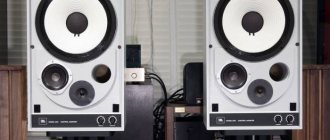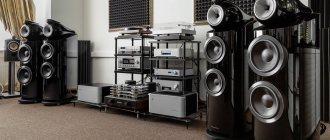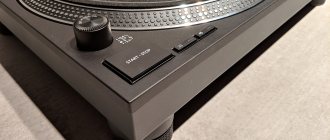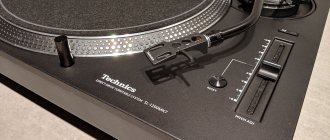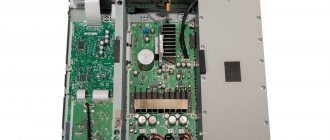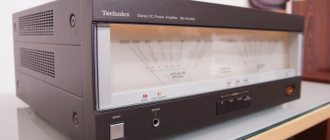Masterpieces of world speaker construction: Technics SB-1000 - the standard speaker from Matsushita
There are devices that remain in the memory of several generations, and sometimes even become firmly established in history and become symbols of their era. It is these devices that I described in my cycles “Legendary Amplifiers” and “Soviet HI-FI and its Creators.” Today we will talk about speakers, and this post will become a pilot in the new series “Legends of World Speaker Construction.” A series of publications will be entirely devoted to acoustics, which, in my subjective opinion and objective data, deserves to be called legendary.
This post is about a speaker system that was compared to such bestsellers as JBL L200 Studiomaster, Yamaha NS-1000, Coral DX-Eleven, Sony SS-G7. The subject of the material is the legendary small-scale Technics SB-1000, which still amazes audio lovers to this day. It is interesting that this acoustics is recognized as one of the best in the world both by representatives of the subjective audiophile and engineering, scientific-psychoacoustic approaches, which in itself is a rarity. Moreover, the system is the subject of a kind of cult and the longed-for dream of many audio equipment collectors. Finding a negative review about this system, as well as it itself, is quite difficult.
Prerequisites for the appearance of the legend
By the end of the 60s, the requirements for the average audio product had increased significantly - this fully applied to speaker systems.
The consumer has become picky both in Europe and the USA, and in Japan itself. People wanted more power with less distortion, and this was the most logical way to develop audio technology. Buying HI-FI and the desire to get high-fidelity sound was becoming a fashionable trend. Even though at that moment there was no corresponding standard, the very concept of High fidelity spread to the masses and began to excite not only limited groups of audiophiles, but also other social groups.
The Japanese corporation was well aware of the current trend and strived to create something conceptually new and striking in both sound quality and design. The company of the great Konosuke Matsushita wanted to maintain leadership in a fairly tough competitive environment, which required appropriate measures.
So Matsushita Electric engineers came up with the idea to create a model that is superior to its analogues in terms of fidelity, functionality, and also has compact overall dimensions. Ideally, the product should have been significantly ahead of its time and given impetus to the development of fundamentally new speaker systems.
An important requirement for the product was the ability to fit into a complex interior, which seriously limited the possibilities of the developers. Also, high levels of distortion and frequency range seriously slowed down development. So the first prototype of the device, launched in 1969, appeared only in 1972. To implement the project, a series of psychoacoustic studies were needed, the results of which were subsequently used repeatedly by the company.
Triumph of a small-batch champion
By the beginning of 1973, it was possible to fully prepare the three-way speaker for series and start production. By 1974, the system appeared at exhibitions and a little later on the shelves of Japanese, European and American stores. The price of the device was relatively high - 220,000 Yen, which today would be about $9,000 taking into account inflation. Critics from the then honest and almost incorruptible audio press responded very flatteringly to the product.
Most of those who shared their impressions of the new speakers noted the accentuated bass reproduction, the extreme frequency range for that time, which went beyond the threshold of human perception, and the clear sound, devoid of noticeable distortion even on a complex symphonic music signal.
Due to the high cost, the company of the great and terrible (cross out) Konosuke Matsushita decided not to launch the device into a full-scale series. Instead, the pragmatists from Technics limited themselves to small-scale production for a narrow circle of audiophiles who understand sound.
A generation-defining design
For 1974, the SB-1000 was a product that distilled years of development and innovation into one device.
New dynamic GGs, unique for that time, were created for the system. In addition, fundamentally new approaches to the development of the housing and structure were tested for the first time, and vibrations were significantly reduced. Sound engineers managed to significantly improve the signal-to-noise ratio in the low-frequency range. The 30 cm conical woofer EAS-30L100S was used as the main one in the low-frequency spectrum. The membrane of this speaker was made of a three-layer composite, which has a high Young's modulus. The membrane is durable and has a low level of frequency distortion.
An improved suspension allows for partial reduction of nonlinear distortion. The diffuser travel hole, located in the magnet, ensures not only unhindered movement of the membrane, but also optimal cooling of the coil. To reduce the running resistance of the diffuser, the magnet has a large hole, which also removes heat well.
The dynamic capabilities of the loudspeaker are provided by a powerful magnetic system with a magnet diameter of 220 mm (magnet size 220x120x23 mm) with a diameter of the speaker itself of 300 mm. Traditionally, such powerful magnets are used in concert equipment. One can hardly remember another case of using such giants in home hi-fi.
The sound in the midrange is provided by a 4.5 cm EAS-18KM100S dome driver, the membrane of which is also made of a three-layer cellulose-carbon composite. The manufacturer also reported that to reduce losses in the midrange drivers, cores made of sheet electrical steel, which has impressive magnetic induction, were used. The stroke of the midrange emitter coil was increased by 7 mm.
. The device's 19mm tweeter, the EAS-12KH100S, was made of titanium alloy with a thickness of only 20 microns. This alloy is 30% lighter than aluminum and has more impressive transient characteristics. The magnetic flux density of the HF emitter is approximately 19,000 Gauss. In addition, the tweeter is equipped with a steel-based silicon alloy choke, which reduces the THD of the tweeter to less than 0.1% per 100W.
An interesting feature is that the connection to the speakers can be done through a crossover or directly to each speaker separately.
The speaker body is made of three layers: surface and inner layers of plywood with a thickness of 9 mm, an intermediate layer of chipboard with a thickness of 18 mm (total 36 mm). Reliable internal damping made it possible to get rid of parasitic resonances, which, according to the manufacturer, do not exist at all. Another feature of the body was the use of vibration-damping coatings on the outside.
- Below I list the dry characteristics of the system:
- Frequency range: 20 – 30000 Hz;
- Sensitivity: 90 dB/W/m;
- Power (DIN): 100 W;
- Resistance: 8 Ohm;
- Crossover cutoff frequencies: 500 Hz and 5000 Hz;
- Overall dimensions (HxWxD): 582x392x397 mm;
- Weight: 52 kg;
Bottom line
The Technics SB-1000 became a kind of standard for a high-fidelity home speaker system until the early 90s, although its production ended already in 1975.
Even today it occupies a place of honor among the epoch-making products of Panasonic (Matsushita Electric). It is remembered today on numerous audio forums, and, as a rule, is classified as a monitor. Considering the characteristics, this is not surprising. If you really want, the legendary and rare vintage can be purchased at auctions. As a rule, the cost of such a speaker in good and perfect condition is no lower than in 1974.
Photographic materials used
ldsound.ru www.technics.com/us
The Pult.ru catalog presents a wide range of acoustic systems
Vintage turntable, choice: Technics SL-1210MK2 against everyone!?
I'm so sorry that this is the 3rd question in 9 days. BUT I’ll die if I don’t choose at least something, I’ve already stopped sleeping(
I looked at the Pro-Ject 2 Xperience Primary, but there is no information about it anywhere, no reviews, no comments, no discussion forums, I searched the entire Russian/English Internet, nothing at all. It’s only about the Pro-Ject 2Xperience SB, but the tonearm is different and the motor is completely different. It's just a pig in a poke. Apparently uninteresting and no one takes it, damn it. And respected local experts didn’t say anything positive. Every second person talked about vintage!
Since I have a little less than zero experience, choosing a used one is a pain in the ass. There seems to be information, but I can’t really understand anything. Respected experts of this forum advised - “you should take a proven, inexpensive used veteran like the Pioneer pl-30Lii” and posted a video (I’m very grateful) in the video the master said that the lift at the tonearm of this model is covered during transportation in 90% of cases !
The fact is that in my city (Novosibirsk) there is no such thing, there is a Pioneer PL-50L for 33,000 rubles, but it’s all shabby (and the design of these tables is terrible, this vinyl film under the red wood uhhh, it’s clear of course - that “checkers or go!”), and there are also all sorts of Victors, and for 30 rubles. and 50 tr. And then there’s the Denon DP70L, it’s not at all clear what league it’s in, is it good or not good!?
I read about them all, there is no direct comparison anywhere, I can’t understand what class they are, the years are different, etc., it’s crazy.
There is a Technics SL-1210MK2 in my city (I attach a photo), as I understand it, the 1210 differs from the 1200 only in color? HE comes with a Shure head, everyone sells it for 35,000 rubles, the head is almost new (I don’t know how to believe it and how to check it), you can see it and touch it. I watched a couple of videos on YouTube on how to check. But without experience, I don’t know if I can implement all the verification techniques from these videos.
On a couple of resources I came across a statement that the Technics of those years were cooler and more reliable, and even more serious in sound than the Pioneers of the same years. Is this really true? Technics sl-1210MK2 vs Pioneer pl-30Lii vs Pioneer PL-50L vs Denon DP70L?
In general, is it worth getting tired of using the Technics SL-1210MK2 for 35,000 rubles (normal price?) or looking at something else, looking for the same Pioneer pl-30Lii?
Or even take a pig in a poke - Pro-Ject 2Xperience Primary for 54,000 rubles. I'm afraid I'll be disappointed in Pro-Ject, but I'll sell it for a maximum of 35,000 rubles. The Technics seems to be proven and has not yet dropped in price; I bought it for a lot and sold it for a lot! This point seems more logical and profitable to me (the money won’t be wasted like with a remake), then I’ll probably understand where to move next!
For the next year then I will live with some kind of MM head in a budget of 15-18000 rubles and the phono preamplifier is most likely a Pro-Ject Phono Box S2 (maybe I should consider something else?)
Thanks a lot to everyone who responded! Once again I apologize for being annoying on the forum!
Vinyl player
Product available in store
TECHNICS SL-1210 MK2 is a legendary turntable that has already become a classic. The Technics SL-1210 MK2 professional turntable is part of the SL1200 series, a recognized standard among DJs around the world for over 30 years. This legendary series dates back to 1973, when Technics released its SL1210 turntable with rotary speed control. The 1979 SL1200mk2 was the first model in the series to feature a slider speed control.
The Technics SL-1210 MK2 vinyl record player has direct drive and quartz speed control. Quick start is ensured by high torque (1.5 kgf/cm). Rotation speed is 33.3/45 rpm. Pitch ±8%. The plate under the needle is illuminated. The lightweight, sensitive S-shaped tonearm with gimbal suspension is adjustable in height. Technics SL-1210 MK2 has an anti-skating system. The cast aluminum body has a solid rubber base that absorbs vibrations. The design of the legs is also designed to absorb vibration.
Functional features:
- Patented direct drive motor design from Technics
- High torque (1.5 kgf/cm), ensuring quick start
- Quartz disk rotation speed stabilization
- Rotation speeds 33 and 45 rpm
- Pitch ±8%
- Red strobe platter speed indicator (+6%, +3.3%, 0%, -3.3%)
- Illumination of the record under the needle, for ease of finding the required section of the track
- Screw-type tonearm height adjustment
- Anti-skating system
- High sensitivity, lightweight S-shape tonearm with gimbal suspension
- Precision die-cast aluminum housing with solid rubber base for vibration absorption
- Vibration-absorbing leg design
Technical characteristics of Technics SL-1210 MK2:
Drive unit:
- Direct drive with quartz stabilization
Disk:
- Aluminum cast
- Diameter: 33.2 cm
- Weight: 1.7 kg
Engine:
- Brushless DC Motor
- Rotation speed adjustment: ±8%
- Starting force: 1.5 kg/cm
- Acceleration time from rest to 33.3 rpm: 0.7 s
Braking system:
- Electronic brake
Detonation:
- 0.01% WRMS
- 0.025% WRMS (JIS C5521)
- ±0.035% peak (IEC 98A Weighted)
Rumble:
- -56 dB (IEC 98A Unweighted)
- -78 dB (IEC Weighted)
Tonearm:
- Effective length: 230 mm
- Adjustable height: 0-6mm
- Overhang: 15mm
- Effective weight: 12g (without cartridge)
- Offset Angle: 22°
- Friction: less than 7 mg (vertical, horizontal)
Tracking error angle:
- within 2° 32′ (on the outer track of a 12″ disk)
- within 0° 32′ (on the inner track of a 12″ disk)
Needle load range:
- 0-4 g
Cartridge weight range:
- 3.5 g – 13 g
- 11 g – 20.5 g (including needle holder)
Cartridge weight range with additional weight:
- 9.5 g – 13 g
- 17 g – 20.5 g (including needle holder)
Cartridge weight range with needle weight:
- 3.5 g – 6.5 g
- 11 g – 14 g (including needle holder)
Other:
- Power supply: built-in AC 220-240V, 50Hz
- Power consumption: 13.5 W
- Dimensions (W x H x D): 453 x 172 x 360mm
- Black color
- Weight: 12 kg
